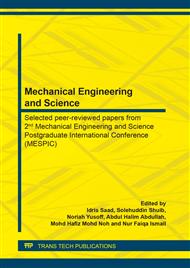p.22
p.31
p.42
p.50
p.61
p.73
p.81
p.94
p.103
Development of Examination Hall Assistive Robot (EHAR)
Abstract:
In this paper, an examination hall assistive robot (EHAR) had been developed to operate in an examination hall, to collect and deliver extra answer booklet for examination candidates. The systems will respond to user or student request through a table transmitter on each table via radio communication. The request by the students is collected by a CPU, before it is transmitted to the robot. The robot moves by following line on floor and read RFID tag for localization purpose. The robot has the ability to stop or avoid obstacle along the path received from the information obtained by the ultrasonic sensors. After the integration process, the performance of the developed system had been tested. The test had been carried out by moving EHAR through 3 points (RFID tags), where EHAR is required to turn on certain angle and direction after each tags read. The test was then repeated for another 10 times to obtained correct average results. The percentages of the average successful turns made by the EHAR are 83.3%. Therefore, it is hoped that this system will be implemented in exam halls and serves its purposes.
Info:
Periodical:
Pages:
61-70
Citation:
Online since:
June 2020
Price:
Сopyright:
© 2020 Trans Tech Publications Ltd. All Rights Reserved
Share:
Citation:


